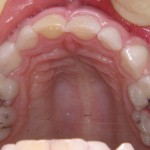
Caries is the commonest childhood disease and untreated decay is present in a large proportion of children by the time their primary dentition is established. Consequently, primary prevention needs to be established in early childhood.
The aim of this study is to measure the effects of a ‘preventive package’ of fluoride varnish, fluoride toothpaste, toothbrush and standard dental health education in keeping young children who regularly attend primary care service free of dental caries, compared with receiving standard dental health education alone.
Methods
Children aged between 2-3 years attending general practice with no caries into dentine, past history of filings or extractions were randomised to either a preventive package of fluoride varnish (22,600 ppm of fluoride varnish applied to all primary teeth), fluoride toothpaste (50-mL tube of 1,450 ppm), toothbrush and standard dental health education or standard dental health education alone at six-monthly intervals. The primary outcome measure was conversion from caries-free to caries-active states (diagnosed at the caries into dentine level), and secondary out- come measures included the number of decayed, missing, or filled teeth surfaces (dmfs-caries into dentine) in children with caries and the number of episodes of pain and extractions.
Results
- 1248 children were randomised (624 in each group)
- 1096 children were examined at 36 months (549 in the test group 547 in the control)
- 187 (34%) of children converted from caries free to caries active in the test group compared with 213(39%) in the control group.
- The difference was not statistically significant; adjusted OR =0.81(95%CI; 0.64–1.04; P = 0.11)
- There was a statistically significant difference in the mean number of carious tooth surfaces 7.2 in the test group compared with 9.6 surface in the control group. An adjusted mean difference of, −2.29 dmfs (95%CI; −3.96 to −0.63; P = 0.007).
- There was no difference in the number of episodes of pain or proportion of children with toothache between the study groups over the 36 months (OR, 0.95; 95% CI, 0.69−1.30; P = 0.74).
- 11.2% of children with caries in the test group had teeth extracted over the 3-y period compared with 13.1% the control group.
- 45 (7.2%) children in the intervention group and 37 (5.9%) in the control reported adverse effects. All were minor and self-limiting.
Conclusions
The authors concluded
This well-conducted randomized controlled trial investigated whether the preventive intervention could keep young children caries free, which is the preventive step change policy makers in the United Kingdom are looking for. The trial had high retention and compliance rates but failed to demonstrate that it did keep children caries free. There is evidence from the trial that once children develop caries, the intervention does slow down its progression. The intervention may have greater impact in a population with high caries levels and if it is delivered in different settings such as schools/nurseries.
Comments
This pragmatic trail in young children has chosen the interesting primary outcome of conversion from caries-free to caries-active states. As the level of diagnosis was caries into dentine children at baseline may have had enamel caries. For the primary outcome no statistically significant difference was found for the primary outcome. However, there was a statistically significance difference in the number of carious lesions prevented in the intervention group compared with the control group of −2.29 dmfs (95%CI; −3.96 to −0.63). The level of caries reduction is similar to the level expected from the use of fluoride varnish. However, and the authors suggest the preventive package used was not sufficient on its own to prevent conversion to caries active status. Given the high consumption of high sugar diets and its key causal in the population the need for a general reduction in sugar consumption through public health measure is important.
Links
Primary paper
Tickle M, O’Neill C, Donaldson M, Birch S, Noble S, Killough S, Murphy L,Greer M, Brodison J, Verghis R, Worthington HV. A Randomized Controlled Trial of Caries Prevention in Dental Practice. J Dent Res. 2017 Apr 1:22034517702330. doi:10.1177/0022034517702330. [Epub ahead of print] PubMed PMID: 28375708.
Other references
Fluoride-based treatments alone are not enough to stop tooth decay in young children
